10 Cheap Coupes with 300+ hp
We love breaking down data in different ways here at Insider. Recently, we decided to look at value through a different lens: cost per horsepower. A healthy discussion ensued, with many of you sharing that you’d gladly pay a little extra for a trimmer body style, a high-performance package, or a V-8.
To our lengthy spreadsheets we returned, playing with the filters to yield a fresh list. This time, we set the threshold at 300 hp and looked only at two-door models. To keep the selection affordable, we restricted ourselves to cars that cost no more than $15,000. We didn’t want to just be talking about rough examples, either, so all values you see here are for vehicles in #3 condition—well-maintained, driver-quality cars, in other words.
The choices vary wildly across the decades. First off, no car in the Hagerty Price Guide from the ’80s meets these criteria. Sports cars with 300 horsepower existed in the ’80s, of course, but none are cheap, as defined here. The same is true for the 2010s: Powerful two-doors abound (hello, C7 Stingray), but they’re well into the $30,000 range. We had to head back to 2010 and Ford’s Mustang (315 hp, $13,600) to meet each of our thresholds. A smattering of foreign cars from the ’90s and ’00s fit our filters, but none show up in any prior decade. Together with how expensive ’80s cars have become, this won’t surprise any good student of automotive history.
In general, you’ll find the richest selection of two-door classics with 300 or more hp in the 1960s or in the 1990s through the 2000s. To make sure no decade is under-represented, we’ve chosen two from each decade—excluding the ’80s, for the reasons listed above.
Without further ado, here are 10 affordable two-doors, most of them with V-8s, and all with 300 or more hp.
2005 Ford Mustang GT
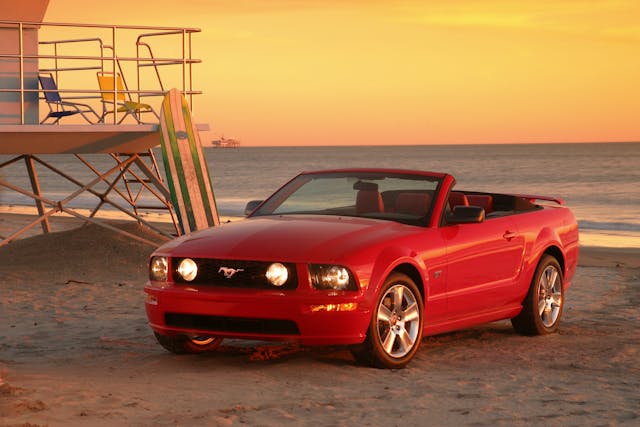
Horsepower: 300
#3 value: $14,800 (convertible)
Mustangs from the S197 generation, especially those that predate the 2010 facelift, are some of the most accessible ways into 300+ horsepower. Even better, both the coupe and convertible variants of the GT model (the entry-level V-8) can be found for under $15K: Droptops are just a skosh under that figure, but the coupes from 2005–09 are only $12,600 in #3 condition. The V-8 got you a host of upgrades from the base V-6 car, plus the glorious exhaust note that’s worth the price of admission in and of itself.
2008 Nissan 350Z Roadster
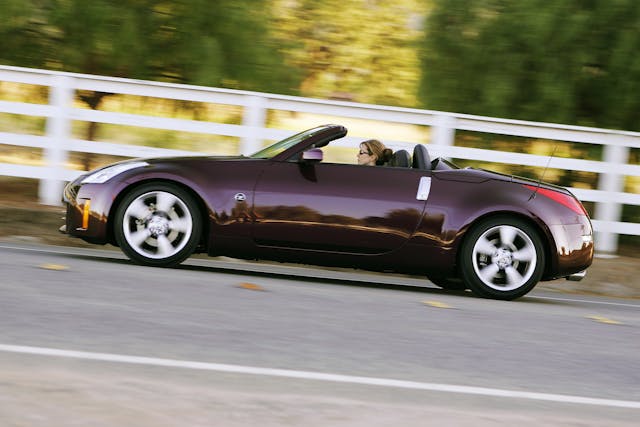
Horsepower: 306
#3 value: $11,600 (Base)
Bucking the usual trend of coupe versus convertibles, the soft-top version of Nissan’s 350Z is the one that’s more affordable. Horsepower varies across the model years, and even among the trim levels until 2007, when Nissan decided to put the same 306-hp variant of its VQ-series V-6 in all of the cars. Redline increased by 500 rpm, to 7500, and fuel economy ticked up, as well. The only downside is the additional cost of the performance goodies: If you want the limited-slip diff, stability control, or cruise control, set aside another two grand and look for the Enthusiast trim. But if you want simple, top-down sporting fun? The base 350Z is your champ.
1999 Chevrolet Camaro Z/28 Coupe
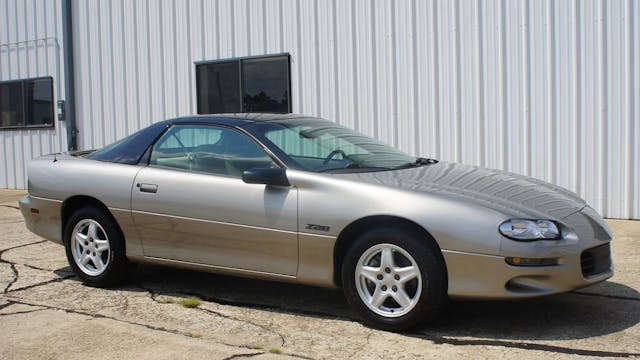
Horsepower: 305
#3 condition value: $12,400
The fourth-gen Camaro follows the general rule that when the top goes down, the price goes up. If you’re on a budget, you can work this to your advantage: a 1999 Z/28 coupe with a manual transmission and the 5.7-liter, 305-hp LS1 goes for $12,400, while the droptop is $20K. (Those who know these cars agree that 305 hp is quite conservative.) This model year also marked the arrival of a Torsen diff for the Z/28 model. Though it ultimately went away after 2002 because of a new head-impact crash standard, the F-body Camaro Z/28 is a stylish, modern, and affordable avenue into the legendary nameplate.
1998 Mercedes-Benz SL500 Roadster

Horsepower: 315
#3 price: $14,800
It’s hard to imagine a stronger contrast between the two foreign-make cars on this list, though both are roadsters. As we noted in our buyer’s guide for this generation (R129) of SL, this luxurious, over-engineered German roadster hails from the cost-is-no-option era of Mercedes-Benz product development. Both elaborate and stout, this 315-hp, V-8-powered droptop is a ton of car for $14,800. This model year is a bit of a sweet spot: Just two years prior, that M119 engine received individual ignition coils, lighter pistons, and a five- rather than a four-speed automatic. A year later in 1999, Mercedes swapped the M119 for the M113, a single- rather than dual-overhead cam V-8 that made 13 fewer horsepower.
1970 Mercury Marauder
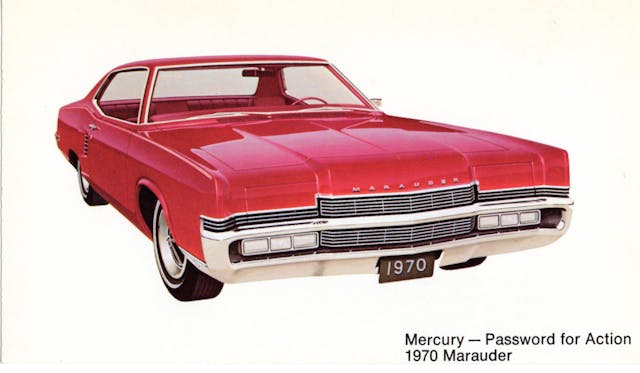
Horsepower: 360
#3 condition value: $13,600
Unlike many of the cars on this list, the ’71 Marauder doesn’t require you to give up its highest-spec engine to stay under fifteen grand. Marauders equipped with the 429-cubic-inch, 360-hp Cobra Jet cost just $13,600 today, and even those with the X-100 package are just $15,200. (Ticking that box added a host of options: automatic transmission, rear fender skirts, two-tone paint, leather upholstery, and alloy wheels.) Dripping with power and luxury, this personal luxury coupe nonetheless didn’t sell that well, but that just means if you show up at a car show with one today, there probably won’t be anything else like it.
1971 Pontiac Grand Prix
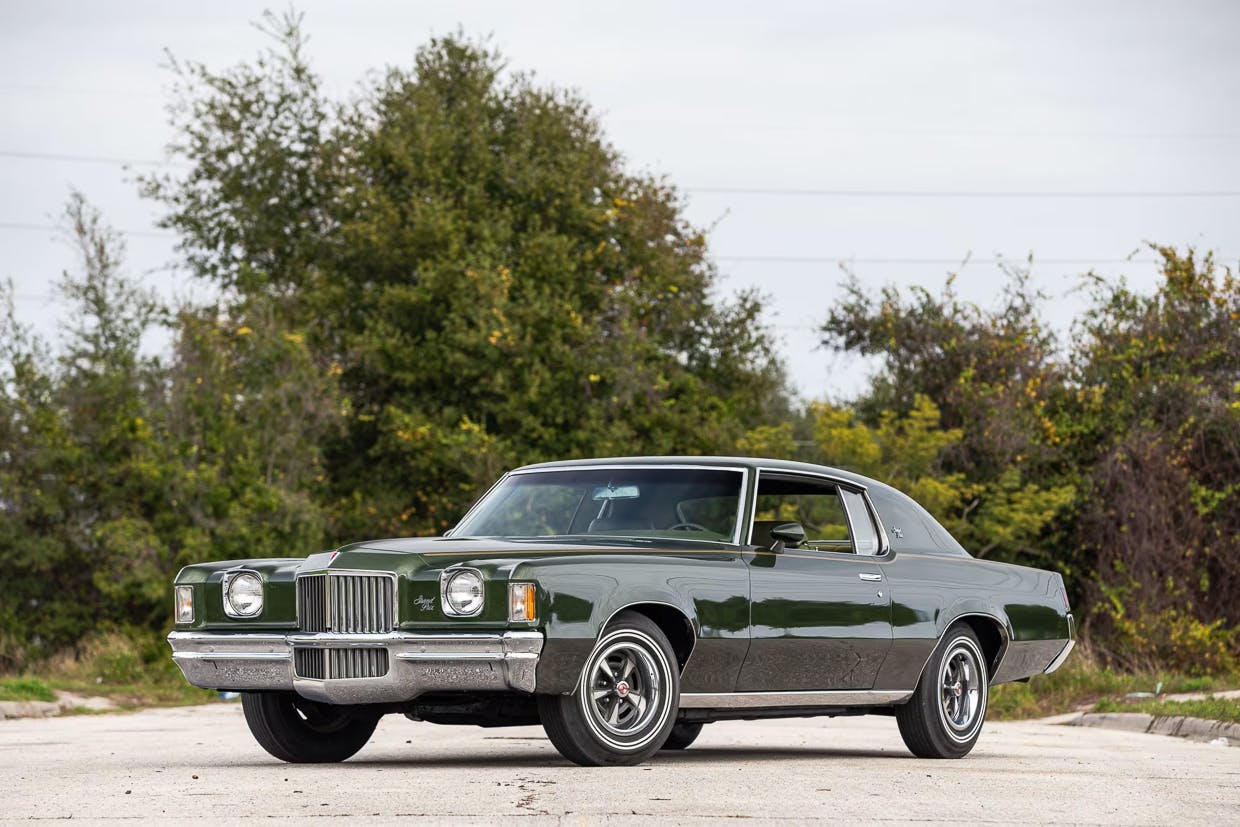
Horsepower: 300
#3 condition value: $14,300
If you dig the ’71 Grand Prix, you don’t just like beak—you like boattail, too. Though not as dramatic as Buick’s Riviera of the same period, Pontiac added the distinctively molded rear deck lid to its personal luxury coupe in ’71. As has been well-told, the ’70s weren’t the best time for big power numbers. Compression began dropping after 1970, the industry method for calculating horsepower changing from gross to net in 1972, and the one-two punch of emissions regulations and fuel crisis impact all conspire to explain why all of the sub-$15K, 300+ horsepower cars from this decade hail from 1970 or 1971.
The best deal for the most powerful Grand Prix is the higher tune of the standard, 400-cubic-inch engine, which squeaks into this list with 300 hp. The 455 was reduced from 370 to 350 hp for ’71, and costs over twice as much today: $32,000 for an example in #3 condition.
1965–69 Avanti II
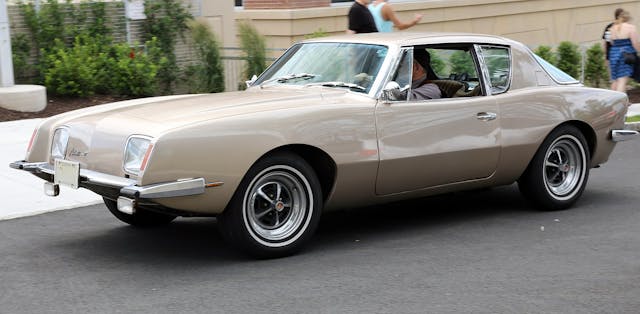
Horsepower: 300
#3 condition value: $13,000
Looking for something powerful but off-beat? Check out the funky fiberglass Avanti II, designed by Studebaker and powered by a Chevy 327 V-8. Available in a wild array of colors, both inside and out, the Avanti II (1965–69) is surprisingly affordable for such an oddball. Values are essentially flat across the production years: a ’65–67 model carries a value just $200 higher than its ’68–69 brethren. These Avantis, produced after original maker Studebaker closed its factory in ’63, reached production thanks to a pair of car dealers from the brand’s home town of South Bend, Indiana, who bought production rights to the model name and a bunch of spare parts.
You’ll pay another 10 percent on top of the Avanti’s #3 value for factory air conditioning or a four-speed … but since that value is $13,000, you’re still under $15K with one or the other desirable add-on.
1968 Oldsmobile Delta 88 Holiday Coupe

Horsepower: 310
#3 condition value: $11,300
Offered across 50 years, the 88 was the top-selling Oldsmobile in the ’50s and the ’60s. As of the 1967 model year, the 88 received a facelift, adding more beak and more fender flare. The following year ushered in some subtle but elegant changes: the center section of the grille was changed to body color, and the turn signals were no longer squeezed in between each pair of round headlamps. The 1968 model year was the last that “Delta” would denote a trim level on the 88; afterward, it was absorbed into the name of the model.
The 88 may not be as coveted as other names of full-sized ’60s performance—Chevrolet’s Impala SS, Ford’s Galaxie—but the ’68 year in particular is one of the best deals for a handsome, powerful muscle car, especially if you forgo the convertible and its $4000 premium: The 425-cubic-inch V-8 made way for a 455-cubic inch mill, adding 10 horsepower, for a total of 310.
1959 Lincoln Premiere Coupe
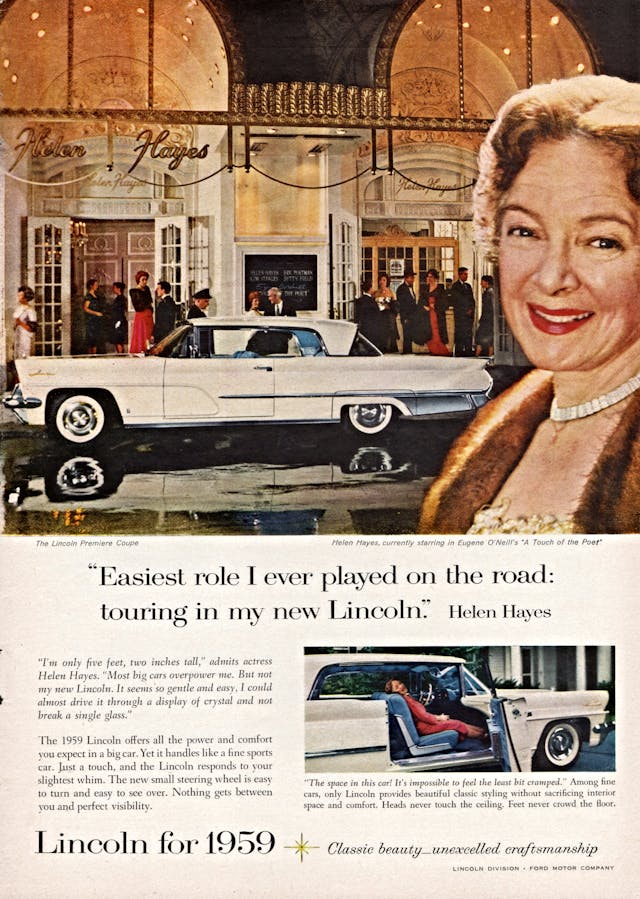
Horsepower: 350
#3 condition value: $13,700
Totally new for 1958, with unibody construction, the Lincoln Premiere immediately established itself as large and in charge—not only in luxurious appointments and overall footprint, but in engine displacement: Both the ’58 and ’59 model years were powered by a 430-cubic-inch V-8, though power dropped from 375 to 350 hp as of 1959. Hardtop sedans were the most popular, and those from ’58 and ’59 both qualify for this list, with #3 values of $13,700 and $12,000, respectively. We’d dare to say that the Thunderbird below, with its separate grille and headlights, looks a bit more modern: But if you want the most luxurious car made by Ford in the ’50s—and if your budget doesn’t stretch to a Continental Mark II—there is no substitute for the Premiere.
1959 Ford Thunderbird Coupe
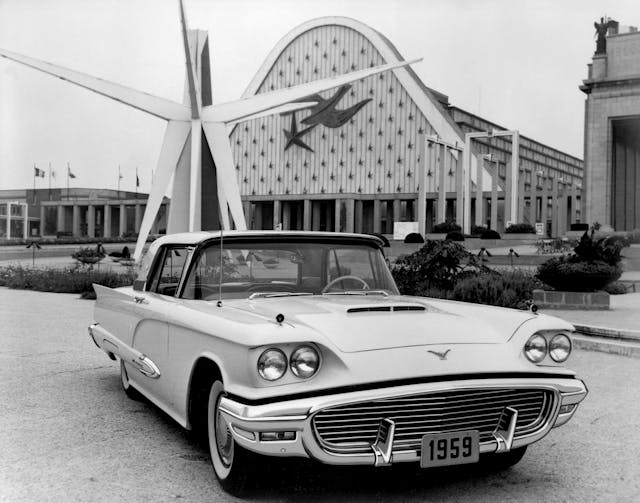
Horsepower: 300
#3 condition value: $13,900
If you’re looking for ’50s glamour and a recognizable model name, the second-gen Thunderbird offers a lot of bang for your buck … especially when you consider that the 1959 coupe is nearly $12K cheaper than the convertible, even when both are equipped with the 352-cu-in engine. Touted in a 1959 brochure as the “newest” version of Ford’s “famous Thunderbird V-8,” this four-barrel powerplant from the FE family was the second-largest engine available for 1959, which saw the introduction of the 430-cu-in MEL V-8. If you’re a big fan of the MEL—we are—consider adding $700 to your budget and buying a ’59 coupe with that engine: You’ll gain an extra 50 hp.
If you’re strict about your $15K budget, however, you may need to do without A/C: The factory-installed option carries a 10 percent premium in our price guide, and even if you go the modern route, and shop the Vintage Air catalog, you’re still looking at $1900 before labor.
***
Want a better understanding of what’s driving collector car values? Sign up for the Hagerty Insider newsletter.



An Avanti at that price in that condition? Schixt! I’ll take out a mortgage and buy FOUR! None of these vehicles could be had for these prices except for maybe the Camaro…….with a Flood Title!
No C4/C5 Corvette? They have been available with 300+hp since 1992 and nice examples are available for under $15k
I have owned two of the cars listed…
WORD OF CAUTION ABOUT THE SL:
I love my ’97. But before you spend money on less than a perfect example, consider a #3 SL is a different creature than a #3 2007 Mustang.
A lot of systems, A lot of fragile plastic. A lot of German parts available from jyst a few online sellers. Some parts are NLA.
Replacing a convertible top is $800 for the top and $2000 for installation thanks to its fiddly power mechanism. I can’t find anyone in my city of 500,000 to do it. Even the MB dealer says no.
You won’t find trim parts at the salvage yard.
Finally,
A nice Mercedes is classy.
A run down #3 Mercedes looks worse than a #4 Mustang…tacky, low rent, etc.
I had an original Studebaker Avanti.
So, the Students 289, not the Chevy 327. The problem with an Avanti II is: weird period colors. So-so build quality…but the largest issue is more power won’t fix the shortcomings of the 1953-designed chassis.
A friend who has driven lots of 50-60s cars, reported my Avanti felt like something from the ’50s.
More hp isn’t going to fix that.
I baffled as to where you got your pricing on the Grand Prix. Can’t find one in #3 condition less than 24K .
Horsepower ratings have always been screwy. A 1970 Buick 455 Stage 1 was rated at 360 hp and would match Hemi cars with 425 hp when tested at the track. The Chevy LS6 was no faster than the Hemi and was rated at 450 hp. Even my 2017 Chevy Impala with the 305hp V6 will give most of the 60s and 70s muscle cars a hard time. One of the issues is that there isn’t enough room in the wheel wells of the early cars to put enough tire on them to provide the traction needed to accelerate like modern cars.
I had a 68 delta 88 in 1976 as a winter car for my parked 67 firebird. Loved that boat, could load a bunch of us in it for Friday night football and basketball games. That thing would go anywhere with the 455.
No love for the 2001 AMGs, like the CLK55s? Great values in the 362hp range, huge torque in the 380 lb-ft range and bulletproof drivetrain. Still affordable as the E55s are taking the heat now.
Like those Ponchos, the Avanti (!), and maybe the Squarebird (if any exist with the 430 and stick-shift!) but bleah the rest, mostly. Besides, we’re talking SAE ‘old skool’ rated (for advertising) BHP, huh? Guess it’s all relative. Our ’62 389 Catalina rated as 303-bhp, but surely couldn’t out run a 270-bhp ’57 Chevy, for one instance. Still, it was a durable and torquey mil (10.5:1-cr., etc,) and with a really good transmission might have done great! Then, there’s the gas mileage penalty…!
Oh, why does the site almost always note that “Youre posting too fast, slow down!” when it’s the first one of the day? Something broken, Haggerty? Wick
The Mercury came with a 360 hp Thunderjet not a cobra Jet
The prices are about right for the Grand Prix. I have a ‘74 with 68 thou on it and that’s what I could probably get for it if I sold it. People think old cars are worth a lot. Buying one the prices are high but selling one is a different story. ( mine is not for sale yet). My wife and I love to drive it around on Sundays when the weather is nice. People comment on the condition when we park by the river.
I bought a brand new 1974 Grand Prix and loved it for about 2 years. At that point the paint started failing (I live in Virginia, nowhere near the ocean or heavily salted roads) And the driver side power window motor enlarged the mounting holes to the point that it rocked back and forth almost a half an inch, so when you put the window all the way up it was still shy of being completely closed by nearly 3/8 in. I seem to remember various pieces of plastic trim on the interior started breaking and coming off in my hand. The ’70s was not GM’s finest hour, as it were. Couldn’t get rid of that thing fast enough.
Most of these are not coupes. They are 2doors. A coupe, by definition, is a 2seater, not a 2 door vehicle.
If you’re talking about the original etymology of the word as it applied to horse-drawn carriages, you would be correct. The word has evolved and and if you take umbrage with it, perhaps you should take it up with the entire automotive industry that for at least the last 70+ years has used that term to describe a coupe or coupé is a passenger car with a sloping or truncated rear roofline and two doors. It is also a commonly accepted that a coupe does not have a frame around the door glass, as opposed to a two-door sedan which does.
I don’t understand how the cars with “gross” HP ratings of about 300 should even be included here. The playing field with the cars after 1971 is just not level; these 300 “gross” HP cars would put out significantly less than 300 HP, stated at “net”. My observations over the years have been that, when comparable numbers could be had (not very often), “net” was about 75 to 80% of “gross”.
Hmmm, ‘04 to ‘07 Volvo V70R and S60R? $12 to $15k will get you a very nice example, and they will actually go around corners really fast, too.
Horsepower measured 5 different ways, vehicle weight all over the map, and a very broad definition of “coupe”. Just a few flaws with the entire piece? For sure! But any premise is good enough to look at some cool cars, right? Might I suggest the same type of article with 1/4 mile times, or 0-60 times? In that vein we’d see how the cars perform in relation to each other, in the real world, rather than just HP specs? There are some very cool cars out there for less than $15k that would blow away some of the “300+” HP boats, with as little as 200 (normally aspirated) HP. Compare cars on the street, not the library!
Where’s my 1974 De Tomaso Pantera L?